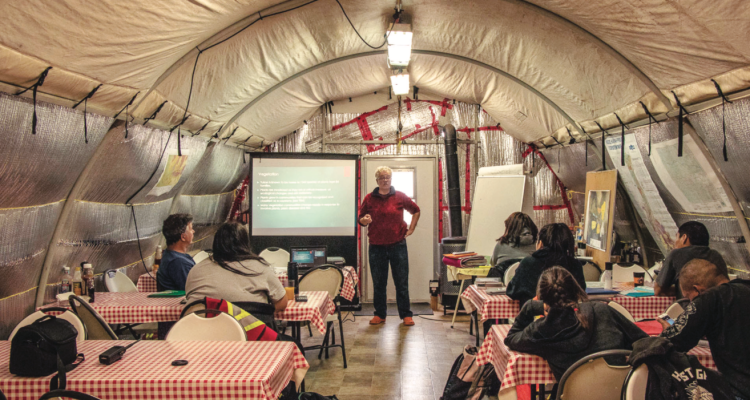Breadcrumbs
On-the-land partnership helps students learn by doing

Environmental monitoring program visits mine exploration site to learn about soil and vegetation
by Levi Garber
SCIENTIST LISA KNIGHT pushes through thick bushes in search of a certain plant to show her class. Nearby, dressed in high-visibility safety vests, the course’s second instructor, David Petkovich, and seven environmental monitoring students wait, curious to see what she finds.
“Why don’t we get in there too?” David says, as he leads the students through the brush to a large slope covered in lichen where Lisa is plucking wild grass.
The group gathers in a circle as Lisa begins explaining the size, shape, and properties of the plant she just picked.
This is just one of the on-the-land lessons shared during a week-long course on terrestrial monitoring of soil and vegetation that took place over the summer at the proposed BMC Minerals Kudz Ze Kayah mine site in south- central Yukon.
The course is one of 10 that Environmental Monitoring certificate students will complete over the 18-month program offered through the Centre for Northern Innovation in Mining at Yukon College.
Sitting in the mess tent that has been transformed into a classroom for the week, David explains why mining companies across the territory have been so inviting to the students.
“All of the mining companies have been really supportive of this program,” he says.
“They think it’s valuable to work with students from the communities, so the students can get some background and some solid training.
Then, the mining companies have the opportunity to hire them as environmental monitors.”
The program has already done courses at both the Minto and Alexco’s Keno Hill mine sites and Bamfield on Vancouver Island.
All the students in the program are from Yukon First Nations communities.
“I love it because we’re out on the land and seeing it, instead of looking at it in a classroom,” say Sheila Caesar, as Lisa and David lead the group back to the campsite.
Sheila, who has already been hired as an environmental monitor for an exploration company, also emphasized the importance of having First Nations youth involved in the program.
She says the program is valuable because they leave the classroom and get first-hand experience in the field.
“The young people get involved and the leadership gets involved and the Elders get involved,” she says. “We’re dealing with the water, the animals, the plants, and everything that affects the ecosystems in our territories.”
David says opportunities for First Nations in the territory will only continue to grow, and programs like this one will help youth be ready.
“The demand is going up for skilled professionals,” he says. “We don’t have a huge population, so a lot of companies are flying people in on rotation from Vancouver to come and sample water and things like that, so it’s better to have those people right here in the Yukon.”
“Because they live in this area, they can also keep an eye on what’s going on and it develops more trust between the communities and the projects,” he adds.
Later in the afternoon, two Elders from Ross River arrive at the camp to teach students how to say plant names in the Kaska language, and to discuss the importance of respecting the land and the water.
“It’s a great experience because it’s very practical,” says student Eric John, who is also from Ross River, as the group finishes up for the day. Eric has been working as an environmental monitor since 2013. He enrolled in this training program to increase his knowledge base and grow professionally.
“There’s really no comparison. You get out there and do some actual sampling,” says David. “We’re trying to give students all the skills they need to go out and do a good job and be safe, and meet the requirements of the site.”
The next course in the program will focus on aquatic monitoring of lakes, rivers, wetlands, and creeks.